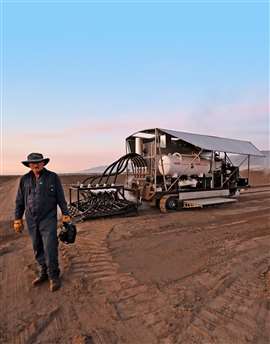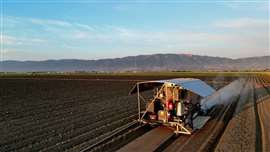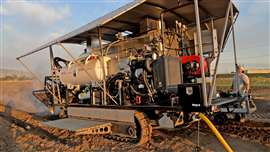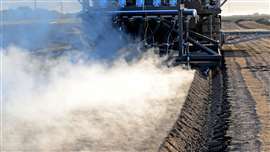This steamer could eliminate chemicals in fresh produce
27 March 2025
Propane Education & Research Council assists in development of engine-driven soil steaming machine.
 Steven Fennimore holds the remote control for a propane-fueled steam applicator that uses a process he developed to reduce or eliminate chemical fumigation in fields of fresh produce. It can also help eliminate hand weeding in crops such as lettuce. (Photo: PERC)
Steven Fennimore holds the remote control for a propane-fueled steam applicator that uses a process he developed to reduce or eliminate chemical fumigation in fields of fresh produce. It can also help eliminate hand weeding in crops such as lettuce. (Photo: PERC)
To protect the health of specialty crops such as strawberries, growers inject chemicals into the soil a few weeks before planting. The fumigant eradicates nematodes, weed seeds and other pathogens that could kill or damage a young plant.
There’s real money at stake. The California Strawberry Commission said growers in the state harvested nearly 220 million trays of strawberries in 2023. California produces 90% of the strawberries grown in the United States and it is the state’s fourth most valuable crop – in 2023 the fruit delivered more than $903,791,000 to Monterey County alone, according to the Monterey County Farm Bureau.
Most Americans assemble their salads with ingredients grown on farms in Monterey County’s Salinas Valley. The strawberry is the county’s most valuable crop with leaf and head lettuce in second and third places.
Methyl bromide was a popular fumigant for years. After California banned its use in crops in 2005, researchers and growers found alternatives in different chemicals and developed new cultivars to resist certain diseases and pests.
Public concern about the application of any chemicals in fresh fruit and vegetable fields has not dissipated over the past two decades, however. That’s why Steven Fennimore has developed field-scale steam applicators that could reduce or eliminate chemical fumigation. Based in Salinas, Calif., he is a Cooperative Extension professor for the University of California, Davis, and has focused his research on weed management since 1997.
Extensive tests with a pull-type implement showed that the concept was ideal for high-value crops such as strawberries, lettuce, carrots and cabbage. It reportedly treats around 90% of annual weeds, resulting in a 73% reduction in weeding time compared to the standard herbicide treatment. Steam can also suppress fungi, diseases and nematodes. Most recently, Fennimore’s research and development work has resulted in an engine-powered machine that applies steam to the seedbed prior to planting.
“I’ve been working on fumigant alternatives for 20 years in Salinas, which is the heart of strawberry production,” said Fennimore. “While organic strawberries are not fumigated, all the other strawberries and fresh produce is. They are a key part of the system, but fumigants are very unpopular. It’s just a just a matter of time before it will no longer be possible to use any of them. Our work has also focused on organic vegetables, because there is a great deal of interest on organic farms because those growers face high hand-weeding costs.”
 The propane-powered soil steamer heats the seed bed to around 160° F for about 20 minutes prior to planting. (Photo: PERC)
The propane-powered soil steamer heats the seed bed to around 160° F for about 20 minutes prior to planting. (Photo: PERC)
Going to the fields
The tests with custom-built pull-type implements spurred the development of a self-propelled soil steamer that was introduced in the Western Propane Gas Association’s booth at California’s World Ag Expo in February.
“I’m working with a researcher from Arizona, and they have really tight end rows,” said Fennimore. “Throughout Arizona and California, vegetable growers are pressed to remain profitable, so now all of their rights-of-way at the end of fields keep shrinking as they work to use as much of their land as they possibly can. We have to be able to turn the machine around. Because land is at a premium, we went to a tracked steamer.”
To help make the step from concept to reality, Fennimore reached out to Peter de Groot, a local engineering consultant who has developed specialized ag machinery throughout his career. The machine was manufactured by Valley Fabrication, an equipment maker in Salinas that has built a wide range of unique machinery for the fresh fruit and vegetable industry. Anderson Industrial Engines provided a 90-hp Kubota engine through its Modesto, Calif., branch. The machine’s hydrostatic drive system helps it maintain the low speeds required to treat an entire field.
To make steam, Fennimore picked propane as a fuel source early in his research. On the self-propelled soil steamer, propane fuels the engine as well as the boilers. He has worked with the Propane Education & Research Council (PERC) since 2020.
“Propane is already an excellent choice for modern agriculture – naturally reducing emissions without compromising efficiency – but this new technology is really a game-changer when it comes to organic and more sustainable food production,” said Michael Newland, director of agriculture business development, PERC. “With this soil steam unit, growers can maintain the optimal crop production necessary to have a successful operation, while also satisfying consumer and regulatory demands for lower emissions and reduced chemical reliance. It’s a win-win situation.”
 Built by Valley Fabrication in Salinas, Calif., the soil steamer uses a propane-fueled boiler and Kubota engine. (Photo: PERC)
Built by Valley Fabrication in Salinas, Calif., the soil steamer uses a propane-fueled boiler and Kubota engine. (Photo: PERC)
Through the grant portal
Virginia-based PERC is a nonprofit that invests in research and development projects for new propane-powered applications. Funded by propane retailers, the organization provides grants to individuals conducting research or who are bringing a propane-powered machine to market. It’s through the group’s grant portal that PERC and Fennimore officially began working together.
“We’ve had a long relationship with him, and we love the technology,” said Newland. “I think it’s a great story in the clean food movement and we’re really excited about partnering with him on this new machine. It combines steam and propane, two things that people are very familiar with, and uses them in a way that’s very unique and very effective.”
Everything is real
Fennimore’s early research helped determine the correct temperature of the steam as well as the duration that steam needed to be applied to the soil to be effective against weed and pest control. When it came to developing the self-propelled soil steamer, projecting how much fuel and water would be used per acre involved a considerable amount of work.
“Because he’s using propane for the engine and the steam, there are a lot of variables, such as with the depth of the injection,” said Newland. “The deeper you go, the more soil volume there is to be heated. Something I hadn’t thought of until I spent some time with Dr. Fennimore was the impact the time of day had. Because the soil cools off overnight, you’ve got a larger delta to raise that cold soil to the specified temperature than you would during the afternoon. When the sun heats the soil up in the afternoon, they can run the machine faster across the ground because you’re not having to lift that soil temperature quite as far. It’s an interesting process.”
 The steaming process essentially pasteurizes the soil. As the soil steamer crawls through the field, the boilers heat the water to around 300° F, creating dry steam that is continuously injected through individual shanks built into the bed shaper. The injectors can be configured for different crop requirements. (Photo: PERC)
The steaming process essentially pasteurizes the soil. As the soil steamer crawls through the field, the boilers heat the water to around 300° F, creating dry steam that is continuously injected through individual shanks built into the bed shaper. The injectors can be configured for different crop requirements. (Photo: PERC)
The process essentially pasteurizes the soil. As the soil steamer crawls through the field, the boilers heat the water to around 300° F, creating dry steam that is continuously injected through individual shanks built into the bed shaper. A narrow band of soil running the length of the seed bed is heated to around 160° F for 15 to 20 minutes. Steam is applied to the top one or two inches of soil, which is a critical area for weed seed germination.
The amount of water the soil steamer uses per acre is comparable to an irrigation system. “We carry enough water on board for a one hour run time,” said Fennimore, “and we have enough fuel for about five hours. For the propane, we go to the end of the field and shut down to refill. But with the water, we’re able to do what we call ‘mid-air fueling,’ but it’s actually ‘mid-air watering.’ We have a tractor pulling a tank with wheel spacings that are aligned with the furrows. The tractor pulls alongside the steamer and in three minutes we can refill the onboard tank. It’s a matter of efficiency to increase the number of acres you treat per day.”
The tracked steamer has been tested on lettuce and carrot fields in California and Arizona, and now Fennimore and the Valley Fabrication team are building a second self-propelled machine designed specifically for strawberry beds. Those beds can be 14 in. high, too tall for the current track design. Expected to be completed this fall, the newest propane-fueled soil steamer will have six wheels, each driven hydrostatically. The wheels are expected to make it easier to clear different seed beds and create a machine that is as flexible as possible.
Commercially available
Fennimore’s goal with the project is to eventually see soil steamers operating commercially throughout Salinas Valley and beyond. The project is ongoing for PERC, as well.
“Our goals from here are to do whatever we can from a marketing and promotional perspective to help him be as successful as possible,” Newland said. “The goal is to make this a profitable entity going forward, and we’re working hard behind the scenes to make sure that our part of the project is successful.”
 Fennimore’s soil steamer crawls through a field in California’s Salinas Valley. (Photo: PERC)
Fennimore’s soil steamer crawls through a field in California’s Salinas Valley. (Photo: PERC)
POWER SOURCING GUIDE
The trusted reference and buyer’s guide for 83 years
The original “desktop search engine,” guiding nearly 10,000 users in more than 90 countries it is the primary reference for specifications and details on all the components that go into engine systems.
Visit Now
STAY CONNECTED




Receive the information you need when you need it through our world-leading magazines, newsletters and daily briefings.
CONNECT WITH THE TEAM









